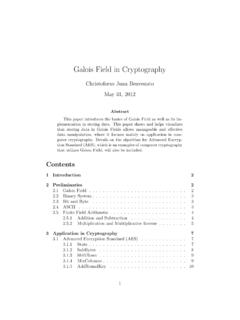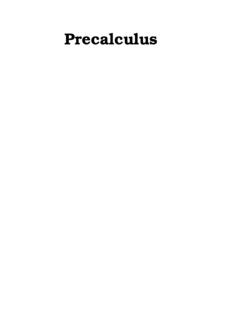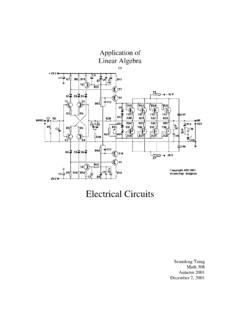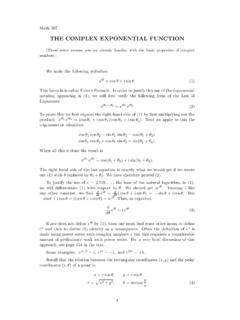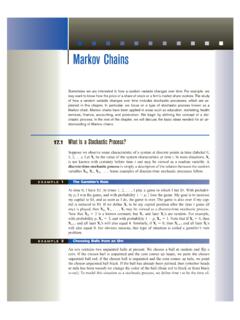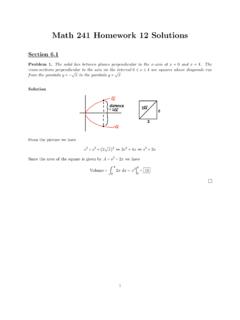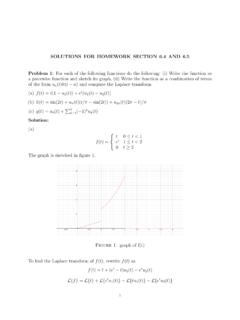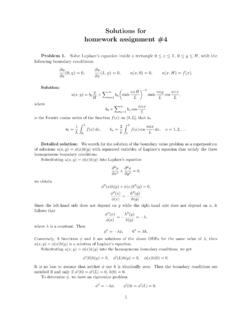Transcription of MATH 402A - Solutions for Homework Assignment 3
1 math 402A - Solutions for Homework Assignment 3. Problem 7, page 55: We wish to find C(a) for each a S3 . It is clear that C(i) = S3 . For any group G and any a G, it is clear that every power of a commutes with a and therefore (a) C(a) . Assume that a S3 and a 6= i. Then a has order 2 or 3. Thus, the subgroup (a) of S3 has order 2 or 3. Since (a) is a subgroup of C(a) and C(a) is a subgroup of S3 (as proved in class one day), Lagrange's theorem tells us that |(a)| divides |C(a)| and that |C(a)| divides |S3 | = 6. It follows that if |(a)| = 2, then |C(a)| = 2 or 6. If |C(a)| = 2, then the fact that (a) C(a) implies that C(a) = (a). However, if |C(a)| = 6, then C(a) = S3 and therefore a is in the center Z(S3 ) of the group S3 . (Here we are using exercise 6 on page 55). Similarly, if |(a)| = 3, then |C(a)| = 3 or 6. If |C(a)| = 3, then the fact that (a) C(a).
2 Implies that C(a) = (a). However, if |C(a)| = 6, then C(a) = S3 and therefore it again would follow that a is in Z(S3 ). It is now useful to point out that Z(S3 ) = {i}. This is easy to verify. We must just verify that if a S3 , and a 6= i, then there exists at least one element b S3 such that ab 6= ba. The following multiplications show this: (123)(12) = (13), (12)(123) = (23) , (132)(12) = (23), (12)(132) = (13) , (23)(13) = (123), (13)(23) = (132) . To complete the solution to this problem, we have already pointed out that C(i) = S3 . However, if a S3 and a 6= i, then a is not in Z(S3 ). As explained above, we then have C(a) = (a). Therefore, if a = (123) or a = (132), then C(a) = (a) = {i, (123), (132)}. If a = (12), (13) or (23), then C(a) = {i, a} in each case. Problem 10, page 55: We assume G is an abelian group and n is a positive integer.
3 Let An = {an | a G}. To see that An is a subgroup of G, we verify the three requirements for a subgroup. First of all, let e denote the identity element of G. Then e = en and so e An . Now if b An , then b = an for some a G. By the law of exponents, b 1 = (a 1 )n and so b 1 An . It remains to verify that An is close under the group operation for G. Suppose that c, d An . We can write c = an , d = bn , where a, b G. We have (1) an bn = (ab)n for any positive integer n. This is because G is assumed to be abelian. To prove (1), we use mathematical induction. For n = 1, (1) is obvious. Suppose (1) is true for some positive integer n. Then (ab)n+1 = (ab)n (ab) = (an bn )(ab) = an (bn a)b = an (abn )b = (an a)(bn b) = an+1 bn+1. which proves the identity for exponent n + 1. Hence, by the principle of mathematical induction, (1) holds for all n 1.
4 Using (1), we obtain cd = an bn = (ab)n . Since ab G, it follows that cd An . Hence An is closed under the group operation for G. Problem 16, page 55: Suppose that G is a group with no proper subgroups. Let e be the identity element of G. One such group is G = {e}, which does not have prime order. Apart from this example, we will prove that G is finite and has prime order. Assume now that G has an element a 6= e. We will fix such an element a in the rest of the argument. First of all, G must be cyclic. To see this, consider H = (a), a subgroup of G containing a. Hence H 6= {e}. Therefore, our assumption about G implies that H = G. Thus, G = (a), the cyclic group generated by a. Now suppose that a has infinite order. This means that ai 6= aj for all pairs i, j Z. such that i 6= j. Consider K = (a2 ). This subgroup is {a2j | j Z}.
5 Since 2j 6= 1 for all j Z, we have a2j 6= a1 = a. Thus, a 6 K. Therefore, K 6= G. Also, a2 6= e since a has infinite order. Thus, K 6= {e}. Therefore, K is a proper subgroup of G. This contradicts our assumption about G. Therefore, a must have finite order. Suppose now that the order of a is m. Then G = (a) has order m. Since a 6= e, we have m > 1. We will prove that m is a prime. Assume to the contrary that m = cd, where c, d Z with 1 < c, d < m. Let b = ad . Let K = (b). Since 0 < d < m, we have b = ad 6= e and hence K 6= {e}. Therefore, by the assumption about G, we have K = G. Thus K has order m. This means that b = ad has order m. However, bc = adc = am = e and 0 < c < m. Hence b cannot have order m. This is a contradiction. Therefore, m is prime and hence, indeed, G has prime order. Problem 17, page 55: Suppose G is a group and x, a G.
6 Let e be the identity element of G. We want to prove that C(x 1 ax) = x 1 C(a)x. Two lemmas will be helpful. Lemma 1: If u, v G, then x 1 (uv)x = (x 1 ux)(x 1 vx). The proof of this lemma is as follows: (x 1 ux)(x 1 vx) = (x 1 u)(xx 1 )(vx) = (x 1 u)e(vx) = x 1 (uv)x Lemma 2: If u, v G and x 1 ux = x 1 vx, then u = v. The proof of this lemma is as follows: x 1 ux = x 1 vx = x(x 1 ux)x 1 = x(x 1 vx)x 1 = eue = eve = u = v 1. We first prove the inclusion x 1 C(a)x C(x 1 ax). Suppose that b x 1 C(a)x. Then b = x 1 cx where c C(a). By definition, we have ca = ac. Then, by lemma 1, b(x 1 ax) = (x 1 cx)(x 1 ax) = x 1 (ca)x = x 1 (ac)x = (x 1 ax)(x 1 cx) = (x 1 ax)b and therefore b C(x 1 ax). Hence x 1 C(a)x C(x 1 ax). 2. Now we prove the inclusion C(x 1 ax) x 1 C(a)x. Suppose that d C(x 1 ax). We can write d = x 1 cx for some c G.
7 To do this, simply take c = xdx 1 . Then x 1 cx = x 1 (xdx 1 )x = (x 1 x)d(x 1 x) = ede = d Now we use lemma 1 to obtain the following equations. d(x 1 ax) = (x 1 cx)(x 1 ax) = x 1 (ca)x, (x 1 ax)d = (x 1 ax)(x 1 cx) = x 1 (ac)x. Since d C(x 1 ax), we have d(x 1 ax) = (x 1 ax)d. The above equations give x 1 (ca)x = x 1 (ac)x Finally, by lemma 2, we have ca = ac. Thus, c C(a). Therefore, d = x 1 cx x 1 C(a)x proving the inclusion C(x 1 ax) x 1 C(a)x. Problem 19, page 55. Suppose A and B are subgroups of an abelian group G. Let H = AB = {ab | a A, b B}. To see that H is a subgroup of G, we verify the three requirements: 1. The identity element e of G is in A and in B. Since we have e = ee, it follows that e is in H. 2. We will show that H is closed under the group operation. To see this, suppose that h1. and h2 are in H.
8 By definition, we have h1 = a1 b1 and h2 = a2 b2 , where a1 , a2 A and b1 , b2 B. Then, using the assumption that G is abelian, we obtain h1 h2 = (a1 b1 )(a2 b2 ) = a1 (b1 a2 )b2 = a1 (a2 b1 )b2 = (a1 a2 )(b1 b2 ). Note that a1 a2 A and b1 b2 B since A and B are subgroups. It follows that h1 h2 H. This proves that H is closed under the group operation for G. 3. Suppose h = ab, where a A, b B. Then h 1 = b 1 a 1 = a 1 b 1. and this is in H because a 1 A and b 1 B. We have proved that H is a subgroup of G. Problem 20, page 55. Let G = S3 . Let A = {i, (12)} and B = {i, (23)}. Both A and B. are subgroups of G. Then AB = {i, (12), (23), (12)(23)} = {i, (12), (23), (123)}. and this set is certainly not a subgroup of G. The set contains (123), but not (123) 1 = (132). Problem 1a, Page 63: The set S is R. For a, b R, we write a b if a b Q.
9 Assume that a, b, c R. We will verify (i) reflexivity, (ii) symmetry, and (iii) transitivity. (i) a a because a a = 0 Q, (ii) a b = a b Q = b a Q = b a (iii) a b, b c = a b, b c Q = (a b) + (b c) Q = a c Q = a c Thus, is an equivalence relation on S. Problem 1b, Page 63: The set S is C. For a, b C, we write a b if |a| = |b|. Suppose that a, b, c C. (i) a a because |a| = |a|, (ii) a b = |a| = |b| = |b| = |a| = b a, (iii) a b, b c = |a| = |b|, |b| = |c| = |a| = |c| = a c Thus, is an equivalence relation on S. Problem 16, Page 64: G = {a1 , .., an } is assumed to be an abelian group of order n. Define f : G G by f (a) = a 1 for all a G. Then f is a function that satisfies f f = i, the identity function from G to G. This follows from the fact that (a 1 ) 1 = a for all a G. Thus, f is an invertible function and must be a bijection from G to G.
10 Therefore, n Y n Y n Y 1. Y n Y. 1 1. x= ai = f (ai ) = (ai ). 1. = ai = ai = x 1. i=1 i=1 i=1 i=n i=1. We have repeatedly used the assumption that G is abelian by rearranging the factors in some of the above products. In any case, we now have x = x 1 and this implies that x2 = e, the identity of G. Problem 17, Page 64: We have x2 = e. If x 6= e, then x has order 2, by definition. We have proved that in any finite group G, the order of an element must divide the order of the group. Therefore, if x 6= e, then |G| is divisible by 2. It follows that if |G| is odd, then x = e. A: Suppose G is a group and a G is an element of finite order. Let m be the order of a. If d is a positive divisor of m, determine the order of ad . If j Z, determine the order of aj . Solution: Suppose that d is a positive divisor of m. Thus, m = cd, where c is a positive integer.
![ZZ dA R [0 2] R - University of Washington](/cache/preview/6/4/c/c/9/f/d/6/thumb-64cc9fd6ac93e2995c04a2a74b217176.jpg)
